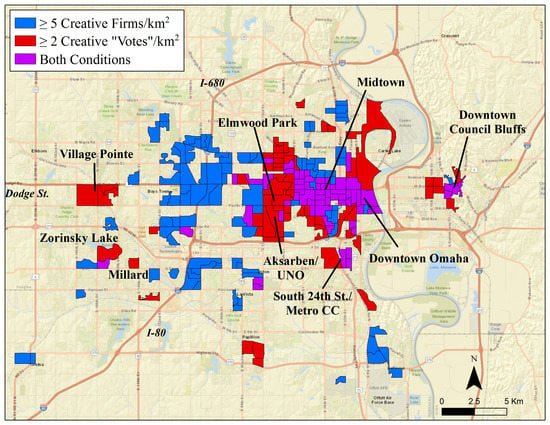Mapping Creative Spaces in Omaha, NE: Resident Perceptions versus Creative Firm Locations
Abstract
:1. Introduction
2. Materials and Methods
2.1. Study Area
2.2. Resident Perceptions
2.3. Creative Firms
2.4. Spatial Point Pattern Test
2.5. Binary Regression Analysis
3. Results and Discussion
3.1. Visualizing Clusters of Creativity
“I feel like the Old Market, the Blackstone District [in Midtown], and Benson all attract creative people. There are businesses, such as creative agencies and design studios. Yoga studios, unique restaurants and bars, and coffee shops also help draw in a creative crowd.”
“I go to downtown Omaha. I like to look at the older buildings. I sometimes pick out one of the older buildings and will look at the architectural details. Sometime [sic] there will be faded advertisements painted on the sides in archaic lettering. Sometimes windows have been bricked up and I wonder about the last time sunlight shined into the building through that particular window. Their [sic] is a story behind each door and around every corner you just have to have an open mind and let your senses talk to you. I especially like when there is street construction. There may be a trench dug deep into the street and I can see the different types of street construction over the years. Just a few reasons how I find inspiration from downtown... there are so many more...”
3.2. Spatial Point Pattern Test
3.3. Binary Logistic Regression Analysis
4. Conclusions
Funding
Conflicts of Interest
References
- Zenker, S. Who’s your target? The creative class as a target group for place branding. J. Place Manag. Dev. 2009, 2, 23–32. [Google Scholar] [CrossRef]
- Durmaz, S.B. Analyzing the quality of place: Creative clusters in Soho and Beyoglu. J. Urban Des. 2015, 20, 93–124. [Google Scholar] [CrossRef]
- Murphy, E.; Fox-Rogers, L.; Redmond, D. Location decision-making of ‘creative’ industries: The media and computer game sectors in Dublin, Ireland. Growth Chang. 2015, 46, 97–113. [Google Scholar] [CrossRef]
- Ochoa, E.A.; Ramirez, P.M.C. Cultural industries and spatial economic growth a model for the emergence of the creative cluster in the architecture of Toronto. City Cult. Soc. 2018. [Google Scholar] [CrossRef]
- Booyens, I. Creative industries, inequality and social development: Developments, impacts and challenges in Cape Town. Urban Forum 2012, 23, 43–60. [Google Scholar] [CrossRef]
- McLean, H. Digging into the creative city: A feminist critique. Antipode 2014, 6, 669–690. [Google Scholar] [CrossRef]
- Grodach, C.; Foster, N.; Murdoch, J. Gentrification, displacement and the arts: Untangling the relationship between arts industries and place change. Urban Stud. 2018, 55, 807–825. [Google Scholar] [CrossRef]
- Yigitcanlar, T.; Baum, S.; Horton, S. Attracting and retaining knowledge workers in knowledge cities. J. Knowl. Manag. 2007, 11, 6–17. [Google Scholar] [CrossRef] [Green Version]
- Gwee, J. Innovation and the creative industries cluster: A case study of Singapore’s creative industries. Innovation 2009, 11, 240–252. [Google Scholar] [CrossRef]
- Zheng, J. ‘Creative industry clusters’ and the ‘entrepreneurial city” of Shanghai. Urban Stud. 2011, 48, 3561–3582. [Google Scholar] [CrossRef]
- Darchen, S.; Tremblay, D.-G. Policies for creative clusters: A comparison between video game industries in Melbourne and Montreal. Eur. Plan. Stud. 2015, 23, 311–331. [Google Scholar] [CrossRef] [Green Version]
- Florida, R. The Rise of the Creative Class; Basic Books: New York, NY, USA, 2002; ISBN 978-1469281421. [Google Scholar]
- Florida, R. The Rise of the Creative Class, Revisited; New Basic Books: New York, NY, USA, 2012; ISBN 978-0465042487. [Google Scholar]
- Marshall, A. Principles of Economics; Macmillan: London, UK, 1890. [Google Scholar]
- Jacobs, J. The Death and Life of Great American Cities; Vintage Books: New York, NY, USA, 1961; ISBN 978-0679741954. [Google Scholar]
- Glaeser, E.L. Learning in cities. J. Urban Econ. 1999, 46, 254–277. [Google Scholar] [CrossRef]
- Markusen, A. Urban development and the politics of a creative class: Evidence from a study of artists. Environ. Plan. A 2006, 38, 1921–1940. [Google Scholar] [CrossRef]
- Kiroff, L. Auckland and the creative industries: The spatial distribution of the design subsector. Urban Geogr. 2017, 38, 1573–1602. [Google Scholar] [CrossRef]
- Spencer, G.M. Knowledge neighborhoods: Urban form and evolutionary economic geography. Reg. Stud. 2015, 49, 883–898. [Google Scholar] [CrossRef]
- Oldenburg, R. The Great Good Place: Coffee Shops, Bookstores, Bars, Hair Salons, and Other Hangouts at the Heart of Community; Marlowe & Company: New York, NY, USA, 1999; ISBN 1-56924-681-5. [Google Scholar]
- Smit, A.J. The influence of district visual quality on location decisions of creative entrepreneurs. J. Am. Plan. Assoc. 2011, 77, 167–184. [Google Scholar] [CrossRef]
- Frenkel, A.; Bendit, E.; Kaplan, S. Residential location choice of knowledge-workers: The role of amenities, workplace and lifestyle. Cities 2013, 35, 33–41. [Google Scholar] [CrossRef]
- Lawton, P.; Murphy, E.; Redmond, D. Residential preferences of the “creative class”? Cities 2013, 31, 47–56. [Google Scholar] [CrossRef]
- Bereitschaft, B. Do ‘creative’ and ‘non-creative’ workers exhibit similar preferences for urban amenities? An exploratory case study of Omaha, Nebraska. J. Urban. 2017, 10, 198–216. [Google Scholar] [CrossRef]
- Brennan-Horley, C.; Gibson, C. Where is creativity in the city? Integrating qualitative and GIS methods. Environ. Plan. A 2009, 41, 2595–2614. [Google Scholar] [CrossRef]
- Lazzeretti, L.; Boix, R.; Capone, F. Do creative industries cluster? Mapping creative local production systems in Italy and Spain. Ind. Innov. 2008, 15, 549–567. [Google Scholar] [CrossRef]
- Darchen, S. ‘Clusters’ or ‘communities’? Analysing the spatial agglomeration of video game companies in Australia. Urban Geogr. 2016, 37, 202–222. [Google Scholar] [CrossRef]
- Coll-Martínez, E.; Arauzo-Carod, J.-M. Creative milieu and firm location: An empirical appraisal. Environ. Plan. A 2017, 49, 1613–1641. [Google Scholar] [CrossRef]
- Gibson, C.; Brennan-Horley, C.; Laurenson, B.; Riggs, N.; Warren, A.; Gallan, B.; Brown, H. Cool places, creative places? Community perceptions of cultural vitality in the suburbs. Int. J. Cult. Stud. 2012, 15, 287–302. [Google Scholar] [CrossRef]
- U.S. Census Bureau. American Community Survey 1-Year Estimates, 2017. Available online: http://factfinder2.census.gov (accessed on 2 May 2018).
- Anderson, K. “Omaha’s Culture Club.” The New York Times. 25 March 2007. Available online: https://www.nytimes.com/2007/03/25/travel/tmagazine/03talk.omaha.t.html (accessed on 10 May 2018).
- Davidson, A. “The Indie-Rock Club Behind Omaha’s $100 Million Creative Boom.” National Public Radio (NPR). 3 June 2011. Available online: https://www.npr.org/sections/money/2011/06/06/136896920/the-indie-rock-club-behind-omahas-100-million-creative-boom (accessed on 10 May 2018).
- Markusen, A.; Wassall, G.H.; DeNatale, D.; Cohen, R. Defining the creative economy: Industry and occupational approaches. Econ. Dev. Q. 2008, 22, 24–45. [Google Scholar] [CrossRef]
- Peck, J. Struggling with the creative class. Int. J. Urban Reg. Res. 2005, 29, 740–770. [Google Scholar] [CrossRef]
- Çetindamar, D.; Günsel, A. Measuring the creativity of a city: A proposal and an application. Eur. Plan. Stud. 2012, 20, 1301–1318. [Google Scholar] [CrossRef]
- Pfeiffer, R.S. The scientific concept of creativity. Educ. Theory 1979, 29, 129–137. [Google Scholar] [CrossRef]
- Csikszentmihalyi, M. Creativity: Flow and Psychology of Discovery and Invention; HarperCollins Publishers: New York, NY, USA, 1996; ISBN 978-0062283252. [Google Scholar]
- Brennan-Horley, C. Multiple work sites and city-wide networks: A topological approach to understanding creative work. Aust. Geogr. 2010, 41, 39–56. [Google Scholar] [CrossRef]
- Lynch, K. The Image of the City; MIT Press: Cambridge, MA, USA, 1960; ISBN 978-0262620017. [Google Scholar]
- Aitken, S.C.; Prosser, R. Residents’ spatial knowledge of neighborhood continuity and form. Geogr. Anal. 1990, 22, 301–325. [Google Scholar] [CrossRef]
- Halseth, G.; Doddridge, J. Children’s cognitive mapping: A potential tool for neighbourhood planning. Environ. Plan. B Urban Anal. City Sci. 2000, 27, 565–582. [Google Scholar] [CrossRef]
- Vertesi, J. Mind the gap: The London underground map and users’ representations of urban space. Soc. Stud. Sci. 2008, 38, 7–33. [Google Scholar] [CrossRef]
- Orleans, P. Differential cognition of urban residents: Effects of social scale on mapping. In Image and Environment: Cognitive Mapping and Spatial Behavior; Downs, R., Stea, D., Eds.; Aldine: Chicago, IL, USA, 2005; pp. 115–130. ISBN 978-0202307664. [Google Scholar]
- Spencer, C.; Weetman, M. The microgenesis of cognitive maps: A longitudinal study of new residents of an urban area. Trans. Inst. Br. Geogr. 1981, 6, 375–384. [Google Scholar] [CrossRef]
- Eng, T.S. Mental maps and residential desirability. Singap. J. Trop. Geogr. 1995, 15, 171–187. [Google Scholar] [CrossRef]
- Matei, S.; Ball-Rokeach, S.J.; Qiu, J.L. Fear and misperception of Los Angeles urban space: A spatial-statistical study of communication-shaped mental maps. Commun. Res. 2001, 28, 429–463. [Google Scholar] [CrossRef]
- Coulton, C.J.; Jennings, Z.M.; Chan, T. How big is my neighborhood? Individual and contextual effects on perceptions of neighborhood scale. Commun. Psychol. 2013, 50, 140–150. [Google Scholar] [CrossRef] [PubMed]
- Evans, G.W.; Brennan, P.L.; Skorpanich, M.A.; Held, D. Cognitive mapping and elderly adults: Verbal and location memory for urban landmarks. J. Gerontol. 1984, 39, 452–457. [Google Scholar] [CrossRef] [PubMed]
- Walmsley, D.J.; Jenkins, J.M. Tourism cognitive mapping of unfamiliar environments. Ann. Tourism Res. 1992, 19, 268–286. [Google Scholar] [CrossRef]
- Beguin, H.; Romero, L. Individual cognition of urban neighborhoods over space and time: A case study. Environ. Plan. A 1996, 28, 687–708. [Google Scholar] [CrossRef]
- Tuan, Y.-F. Images and mental maps. Ann. Association Am. Geogr. 1975, 65, 205–212. [Google Scholar] [CrossRef]
- Vajjhala, S.P. Integrating GIS and Participatory Mapping in Community Development Planning. In Proceedings of the Twenty-Fifth Annual ESRI User Conference, San Diego, CA, USA, 25–29 July 2005; Available online: http://www.iapad.org/wp-content/uploads/2015/07/pap1622.pdf (accessed on 16 April 2018).
- U.K. Department of Culture, Media and Sport (DCMS). Creative Industries Mapping Documents 2001. Available online: https://www.gov.uk/government/publications/creative-industries-mapping-documents-2001 (accessed on 20 May 2018).
- Higgs, P.; Cunningham, S.; Bakhshi, H. Beyond the Creative Industries: Mapping the Creative Economy in the United Kingdom; Technical Report; NESTA: London, UK, 2008; Available online: https://eprints.qut.edu.au/12166/1/beyond_creative_industries_report_NESTA.pdf (accessed on 22 May 2018).
- Spencer, G.M. Local diversity and the spatial concentration of creative economic activity in Canadian city regions. In Beyond Territory: Dynamic Geographies of Knowledge Creation and Innovation; Bathley, H., Feldman, M., Kogler, D., Eds.; Routledge: New York, NY, USA, 2011; pp. 46–63. ISBN 978-0-415-49327-7. [Google Scholar]
- U.S. Office of Management and Budget. North American Industry Classification System; U.S. Office of Management and Budget: Washington, DC, USA, 2017.
- Andresen, M.A. Testing for similarity in area-based spatial patterns: A nonparametric Monte Carlo approach. Appl. Geogr. 2009, 29, 333–345. [Google Scholar] [CrossRef]
- Andresen, M.A. An area-based nonparametric spatial point patterns test: The test, its applications, and the future. Methodol. Innov. 2016, 9, 1–11. [Google Scholar] [CrossRef]
- Malleson, N. Andresen SpatialTest (Java). Available online: https://github.com/nickmalleson/spatialtest (accessed on 2 May 2018).
- Openshaw, S. The Modifiable Areal Unit Problem (Concepts and Techniques in Modern Geography No. 38); Geo Books: Norwich, UK, 1984; ISBN 0-86094-134-5. [Google Scholar]
- U.S. Census Bureau. Sex by Occupation for the Civilian Employed Population 16 Years and Over. 2012–2016 American Community Survey (ACS) 5-Year Estimate (2016). Available online: http://factfinder2.census.gov (accessed on 20 September 2017).
- Environmental Systems Research Institute (ESRI). USA Parks. Data Layer Package, Created 2 November 2010. Available online: https://www.arcgis.com/home/item.html?id=578968f975774d3fab79fe56c8c90941 (accessed on 19 June 2018).
- Oppezzo, M.; Schwartz, D.L. Give your ideas some legs: The positive effect of walking on creative thinking. J. Exp. Psychol. Learn. Mem. Cogn. 2014, 40, 1142–1152. [Google Scholar] [CrossRef] [PubMed]
- Bowler, D.E.; Lisette, M.; Ali, B.; Knight, T.M.; Pulli, A.S. A systematic review of evidence for the added benefits to health of exposure to natural environments. BMC Public Health 2010, 10, 456. [Google Scholar] [CrossRef] [PubMed]
- Plambech, T.; Konijnendijk van den Bosch, C.C. The impact of nature on creativity—A study among Danish creative professionals. Urban For. Urban Green. 2015, 14, 255–263. [Google Scholar] [CrossRef]
- Roe, J.; Aspinall, P. The restorative benefits of walking in urban and rural settings in adults with good and poor mental health. Health Place 2011, 17, 103–113. [Google Scholar] [CrossRef] [PubMed]
- Howells, J. Tacit knowledge, innovation and economic geography. Urban Stud. 2002, 39, 871–884. [Google Scholar] [CrossRef]
- Walk Score®. 2018. Available online: https://www.walkscore.com/methodology.shtml (accessed on 24 June 2018).
- Gehl, J. Life between Buildings: Using Public Space; Van Nostrand Reinhold: New York, NY, USA, 1987; ISBN 978-1597268271. [Google Scholar]
- Whyte, W.H. City: Rediscovering the Center; University of Philadelphia Press: Philadelphia, PA, USA, 1988; ISBN 978-0812220742. [Google Scholar]
- Bille, T. Cool, funky and creative? The creative class and preferences for leisure and culture. Int. J. Cult. Policy 2010, 16, 466–496. [Google Scholar] [CrossRef]
- Woldoff, R.A.; DeCola, T.; Litchfield, R.C. The aspirational creative class: Urban residential preferences of college students in creative majors. City Cult. Soc. 2011, 2, 75–83. [Google Scholar] [CrossRef]
- Environmental Systems Research Institute (ESRI). “World Street Map,” ArcGIS Online Basemap, Data Sources: Esri, DeLorme, HERE, USGS, Intermap, iPC, NRCAN, Esri Japan, METI, Esri China (Hong Kong), Esri (Thailand), MapmyIndia, Tomtom. 2009. Available online: http://www.arcgis.com/home/item.html?id=3b93337983e9436f8db950e38a8629af (accessed on 11 February 2018).
- Hamidi, S.; Zandiatashbar, A. Does urban form matter for innovative productivity? A national level study of the association between neighbourhood innovation capacity and urban sprawl. Urban Stud. 2018. [Google Scholar] [CrossRef]
- Kuiper, J. “The 8 best spots in the Omaha area to drink, dine and dance.” Omaha World-Herald. 1 February 2015. Available online: http://www.omaha.com/special_sections/outlook/the-best-spots-in-the-omaha-area-to-drink-dine/article_5a101e74-ae68-5822-920a-dbf637d25e53.html (accessed on 15 May 2018).
- Scott, B. Benson Ranked Among the “Hippest U.S. Neighborhoods.” WOWT 6 News. 16 July 2015. Available online: http://www.wowt.com/home/headlines/Benson-Now-Ranks-Among-Top-Hip-US-Neighborhoods-316044571.html (accessed on 15 May 2018).
- Solnit, R. Wanderlust: A History of Walking; Penguin Books: New York, NY, USA, 2000; ISBN 978-0140286014. [Google Scholar]
- Shortell, T.; Brown, E. (Eds.) Walking in the European City: Quotidian Mobility and Urban Ethnography; Routledge: New York, NY, USA, 2014; ISBN 978-1-4724-1616-2. [Google Scholar]
- Drake, G. ‘This place gives me space’: Place and creativity in the creative industries. Geoforum 2003, 34, 511–524. [Google Scholar] [CrossRef]
- Godin, B.; Gingras, Y. The place of universities in the system of knowledge production. Res. Policy 2000, 29, 273–278. [Google Scholar] [CrossRef] [Green Version]
- Acosta, M.; Coronado, D. University spillovers and new business location in high-technology sectors: Spanish evidence. Small Bus. Econ. 2011, 36, 365–376. [Google Scholar] [CrossRef]
- Guerini, M.; Rossi-Lamastra, C. How university and industry knowledge interact to determine local entrepreneurship. Appl. Econ. Lett. 2014, 21, 513–516. [Google Scholar] [CrossRef]
- Burbach, K. “UNMC Achieves New Record for Research Grants, Contracts.” University of Nebraska at Omaha Newsroom. 28 September 2017. Available online: https://www.unmc.edu/news.cfm?match=21027 (accessed on 23 May 2018).
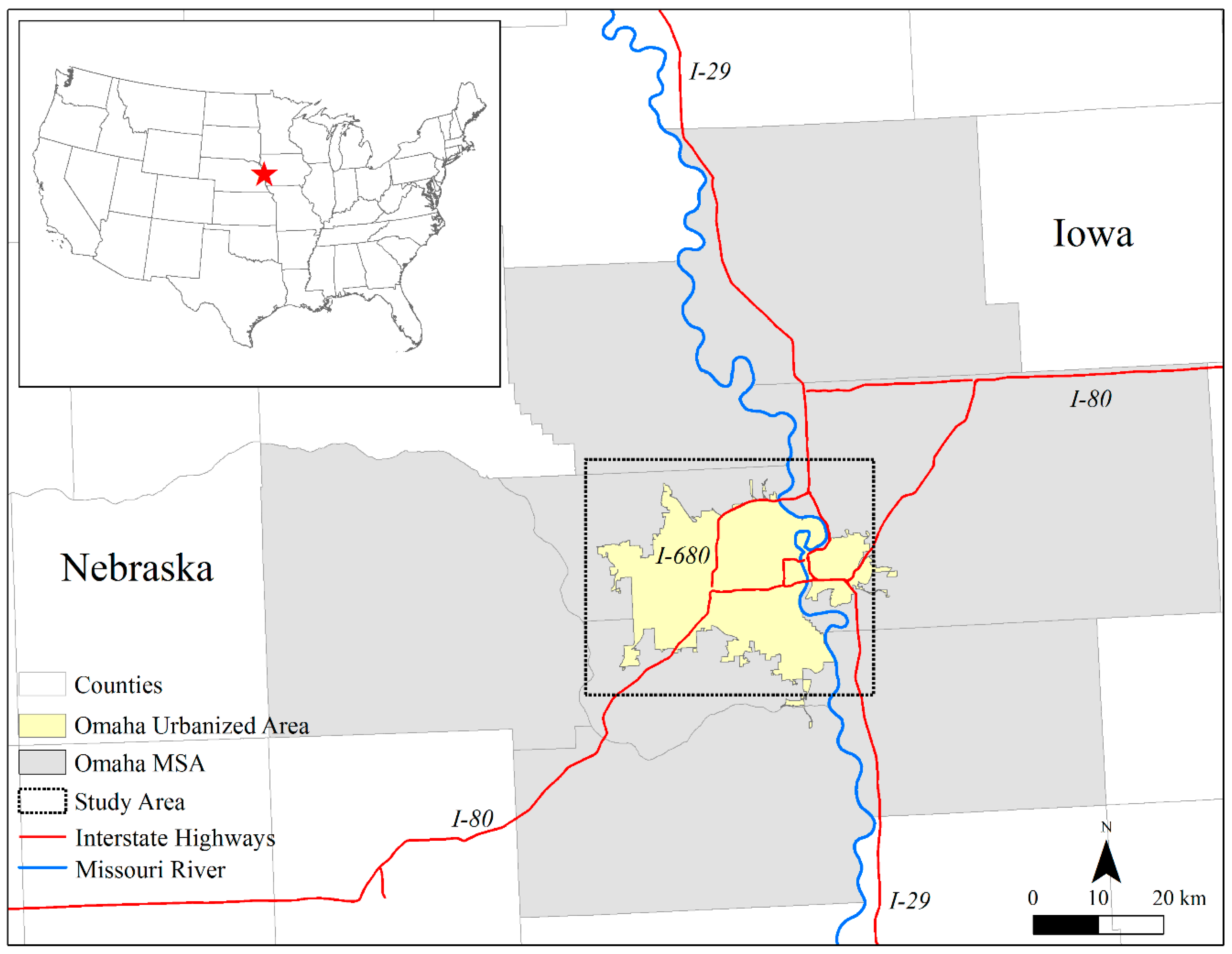
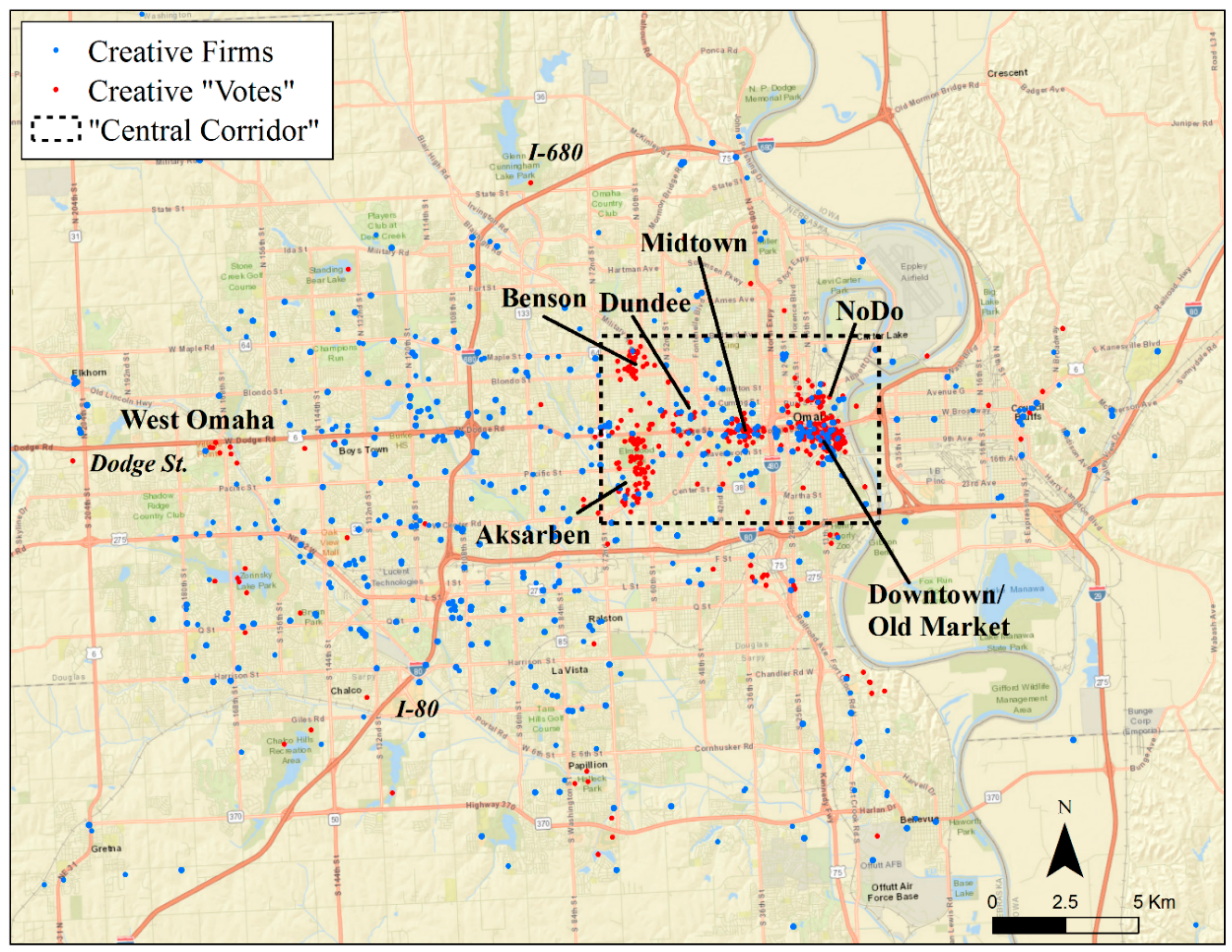

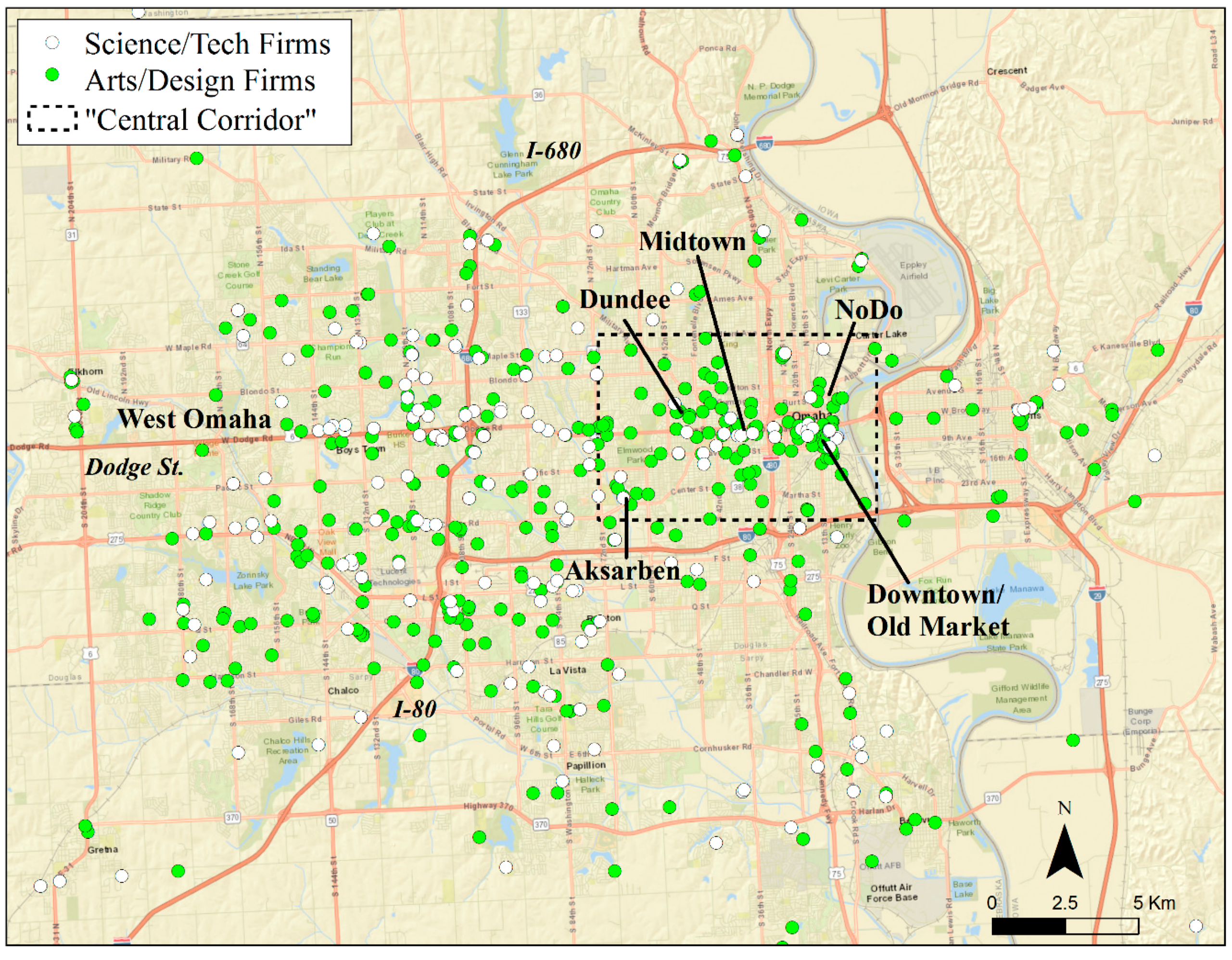
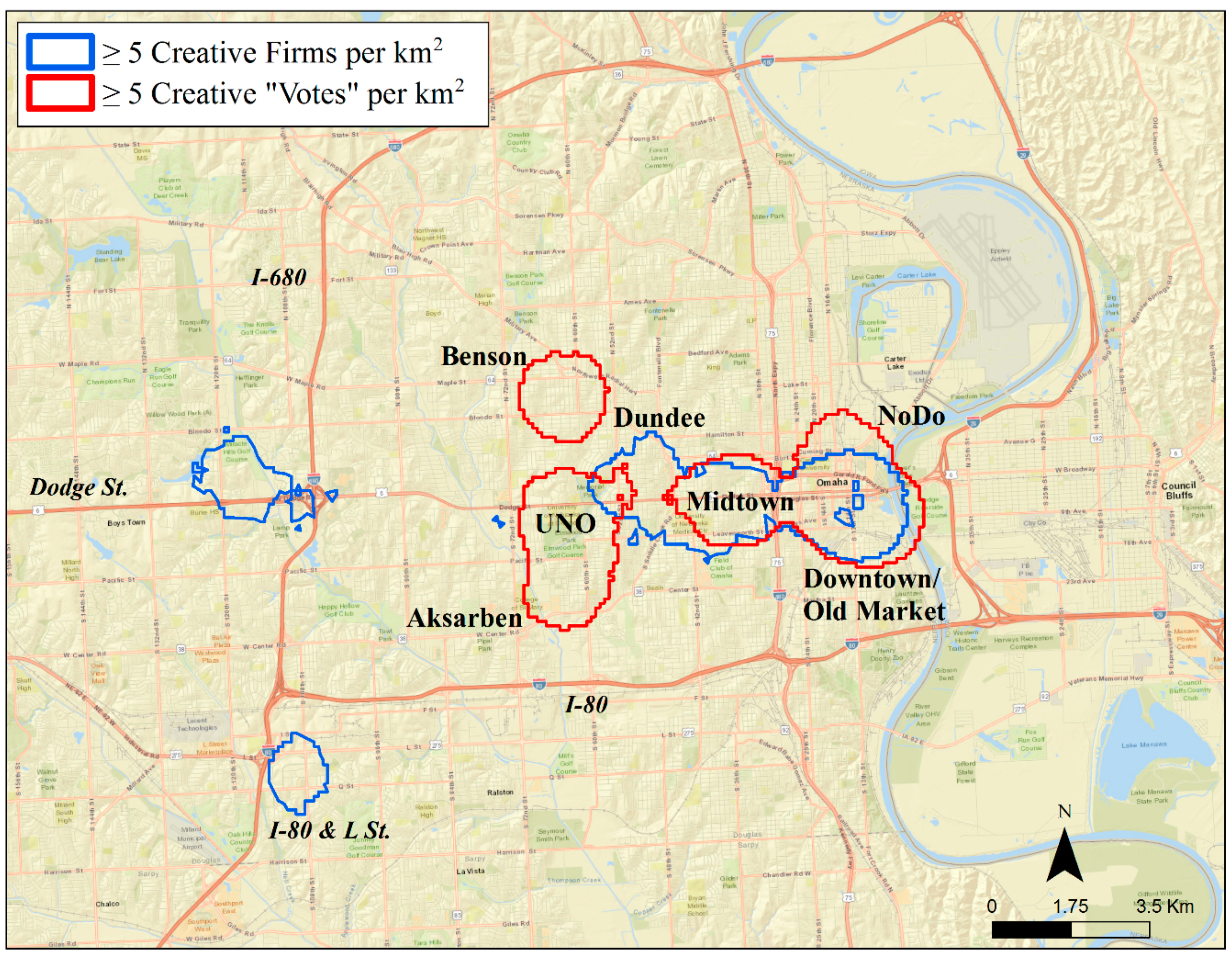

| NAICS | Description | Type |
|---|---|---|
| 453920 | Art Dealers | Art/Media |
| 541810 | Advertising Agencies | Art/Media |
| 541512 | Computer Systems Design Services | Science/Tech |
| 611610 | Fine Art Schools | Art/Media |
| 711510 | Independent Artists, Writers & Performers | Art/Media |
| 512110 | Motion Pictures & Video Production | Art/Media |
| 712110 | Museums | Art/Media |
| 512230 | Music Publishers | Art/Media |
| 711130 | Musical Groups & Artists | Art/Media |
| 711190 | Other Performing Arts Companies | Art/Media |
| 512290 | Other Sound Recording Industries | Art/Media |
| 515112 | Radio Stations | Art/Media |
| 512240 | Record Production & Distribution | Art/Media |
| 5417 | Scientific Research & Development Services | Science/Tech |
| 5112 | Software Publishers | Science/Tech |
| 512240 | Sound Recording Studios | Art/Media |
| 515120 | Television Broadcasting | Art/Media |
| 711110 | Theater Companies & Dinner Theaters | Art/Media |
| Creativity Survey | Metro Omaha | |
|---|---|---|
| % Female | 61 | 50 |
| Median age | 53 | 35 |
| % Aged 19–49 | 31 | 41 |
| % Aged 65+ | 27 | 12 |
| % BA or higher | 76 | 23 |
| % Grad degree | 31 | 12 |
| Avg. household income | $104,000 | $79,000 |
| w/All Firms | w/Arts Firms | w/Science Firms | |||||||
|---|---|---|---|---|---|---|---|---|---|
| B | S.E. | Sig. | B | S.E. | Sig. | B | S.E. | Sig. | |
| Constant | −0.218 | 0.921 | 0.813 | −0.078 | 0.917 | 0.932 | −0.232 | 0.933 | 0.062 |
| Log (Dist. to Park) | −0.195 | 0.076 | 0.010 | 0.198 | 0.076 | 0.009 | −0.188 | 0.076 | 0.013 |
| Log (Dist. to Uni.) | −0.336 | 0.081 | <0.001 | −0.337 | 0.080 | <0.001 | −0.354 | 0.082 | <0.001 |
| Walk Score | 0.053 | 0.008 | <0.001 | 0.050 | 0.008 | <0.001 | 0.057 | 0.008 | <0.001 |
| Log(% Creative) ǂ | −0.152 | 0.125 | 0.223 | −0.146 | 0.125 | 0.243 | −0.122 | 0.123 | 0.319 |
| All Firms a | 0.581 | 0.261 | 0.026 | -- | -- | -- | -- | -- | -- |
| Art Firms b | -- | -- | -- | 0.941 | 0.273 | 0.001 | -- | -- | -- |
| Science Firms c | -- | -- | -- | -- | -- | -- | 0.362 | 0.339 | 0.266 |
| Model r2 (Nagelkerke) | 0.344 | 0.357 | 0.338 | ||||||
© 2018 by the author. Licensee MDPI, Basel, Switzerland. This article is an open access article distributed under the terms and conditions of the Creative Commons Attribution (CC BY) license (http://creativecommons.org/licenses/by/4.0/).
Share and Cite
Bereitschaft, B. Mapping Creative Spaces in Omaha, NE: Resident Perceptions versus Creative Firm Locations. ISPRS Int. J. Geo-Inf. 2018, 7, 263. https://doi.org/10.3390/ijgi7070263
Bereitschaft B. Mapping Creative Spaces in Omaha, NE: Resident Perceptions versus Creative Firm Locations. ISPRS International Journal of Geo-Information. 2018; 7(7):263. https://doi.org/10.3390/ijgi7070263
Chicago/Turabian StyleBereitschaft, Bradley. 2018. "Mapping Creative Spaces in Omaha, NE: Resident Perceptions versus Creative Firm Locations" ISPRS International Journal of Geo-Information 7, no. 7: 263. https://doi.org/10.3390/ijgi7070263



